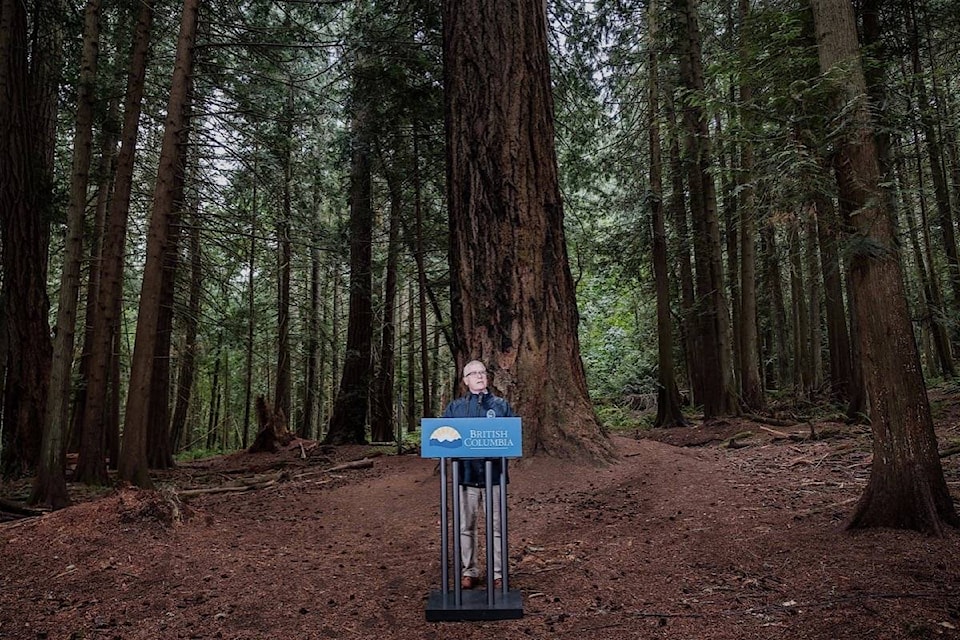Jim HILTON
Special to the Tribune
As promised, the BC Government has published a discussion paper which includes a number of questions for public input.
The link “engage.gov.bc.ca” provides access to the 19-page “Interior Forest Sector Renewal Policy and Program Engagement Discussion Paper.” The report contains the following topics along with questions in each of the seven sections:
1.) Forest Tenure and Fibre Supply
2.) Fibre and Sustainability of Timber and Non-Timber Values
3.) Climate Change and Forest Carbon
4.) Manufacturing Capacity and Fibre Utilization.
5.) Wood Products Innovation.
6.)Timber Pricing and the Softwood Lumber Dispute and
7.) Reconciliation with Indigenous Nations.
Doug Donaldson, Minister of Forests, Lands, Natural Resource Operations and Rural Development, provides a brief history of what led up to this document. He also encourages the public to join the dialogue and to provide ideas on opportunities to benefit our forest products economy, support reconciliation with Indigenous communities, ensure a sustainable, competitive future for our forest products industry and support communities and families for generations into the future.
A number of maps and charts along with the following written material provides readers a lead into the questions.
“While it was always known that mill closures would be an eventual consequence of the MPB epidemic, the policy and transition planning work that should have been done to prepare for impacts was neglected.
As a result, we are grappling today with the process of rethinking B.C.’s policy approach to doing business from a reduced timber supply – while simultaneously reconfiguring our relationship with Indigenous communities, helping to transition workers and their families, and charting a new future for resilient forestry communities and competitive forest companies.
Today, B.C. represents more than half of Canada’s total softwood lumber production. In 2018, forest products represented 32 per cent of B.C.’s total exports, valued at $14.89 billion. In 2018, the interior forest sector contributed approximately 57 per cent of B.C.’s total forest gross domestic product, employment and output value. Forestry represented direct employment of 33,125 people distributed across 96 communities.
READ MORE: Community forests have many advantages for rural communities
The forest products industry is capital-intensive, involving high-cost, technologically-advanced harvesting equipment and high-volume, high-tech, increasing automated manufacturing facilities. Competitiveness is highly sensitive to costs – including fibre costs, labour costs and the unit costs of production.
Lumber prices in the U.S. have fallen from highs of U.S. $600-plus / mfbm (thousand board feet) in late 2018 to as low as U.S. $306 in early 2019, having since rebounded and hover between the high U.S. $300 to low U.S. $400 range. At higher lumber prices, forest companies were willing to compete aggressively for incremental fibre sold through the B.C. Timber Sales (BCTS) program. BCTS sales provide a market pricing benchmark used in stumpage calculations, translates into higher stumpage rates through the Market Pricing System — a necessary part of access to B.C.’s access to U.S. lumber markets. While this system cannot be adjusted without consequences in our trade relationship with the U.S., the high log costs resulting from earlier competition for fibre are a challenge for the industry.
ALSO READ: Government commits to revitalization of Coast forest industry
In addition, B.C. faces ongoing impacts resulting from the softwood lumber trade dispute with the U.S., including countervailing duties presently applied on B.C. lumber and some other forest products. While B.C. is confident that this trade action and the related import tariffs will be overturned by an international trade panel as has been the case in the past, in the interim, companies are required to post bonds on lumber imports that adversely affect companies cash flows.”
Jim Hilton is a professional agrologist and forester who has lived and worked in the Cariboo Chilcotin for the past 40 years. Now retired, Hilton still volunteers his skills with local community forests organizations.
Do you have a comment about this story? email:
editor@wltribune.com
Like us on Facebook and follow us on Twitter.
